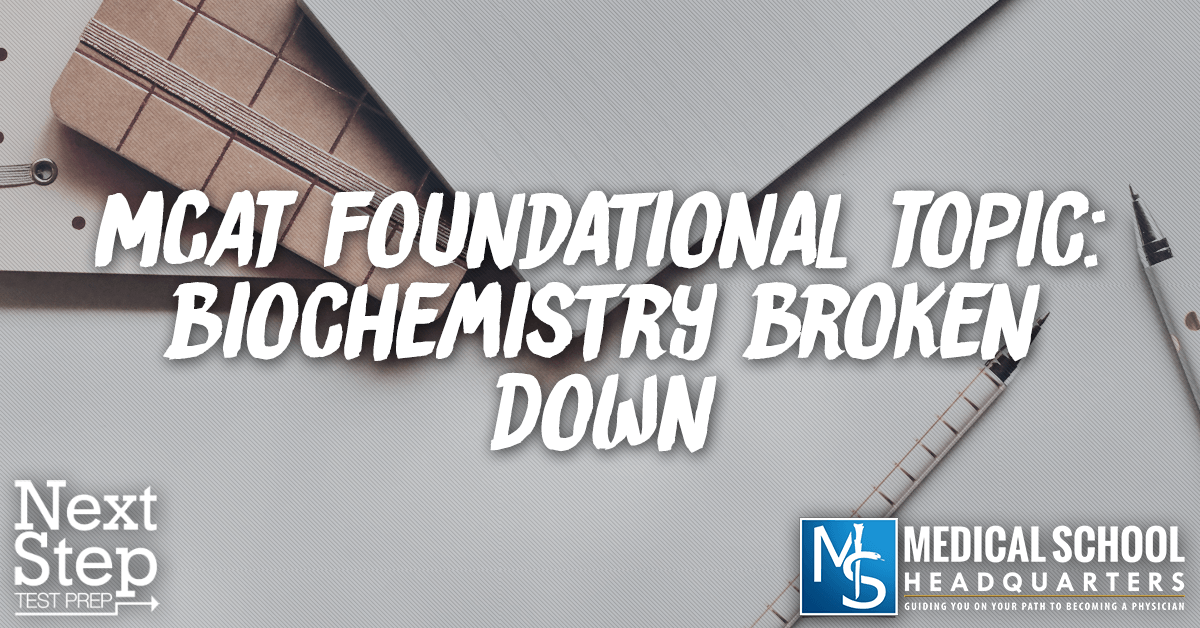Apple Podcasts | Google Podcasts

Session 81
Biochemistry is a foundational topic on the MCAT and we’re going to cover some of the foundational pieces of information that you’re expected to know on the test.
Bryan Schnedeker from Blueprint MCAT (formerly Next Step Test Prep) is joining us again to discuss some biochem questions to help students get the score they need.
Bryan explains that while the cell is the fundamental thing in Bio, in Biochemistry, the real foundational thing would be proteins and amino acids.
Check out all the other podcasts on MedEd Media Network.
[01:55] Beer’s Law
Question 2: The absorbents of a protein solution is 3.37. If the concentration of the solution is known to be 4 moles and the path length is 1cm, which value best approximates the extinction coefficient?
- (A) 0.04
- (B) 0.08
- (C) 2
- (D) 5
Bryan’s Insights:
3.37 = extinction coefficient (x) x concentration (4) x path length (1)
This is a typical MCAT math where it looks like it’s going to be ugly numbers but calculating it, x is just a number a little less than 1. So the 4 goes down to 3.37. In this case, the answer that’s a little bit less than 1 is (B).
Bryan says that on the MCAT, you can always approximate your answers since you’d notice how far the answer choices are. They usually range the choices from 200-300% bigger or smaller than each other all the way up to tens of thousands of times bigger and smaller than each other. So you only have to get vaguely close.
Bryan points out that it’s probably better that MCAT does not allow the use of calculator, otherwise, they would require precision in your answer and this can be very challenging.
[04:50] Protein Structures
Question 3: A particular protein largely lacks both secondary and tertiary structure. Which factor, if any, is responsible for the resting state of the proteins.
- (A) Entropy
- (B) Hydrogen bonds between amino acid residues
- (C) Dipole to dipole interactions
- (D) None of the above
Bryan’s Insights:
An important thing to notice here is that hydrogen bonds between amino acid residues are important for secondary structure. But the question here says “lacks” secondary structure. Hence, (B) is out.
(C) is a classic part of tertiary structure. Again, the question is looking for protein that lacks tertiary structure so this is also out.
Now, something has to account for the how the protein settles itself. And the answer is (A).
[06:25] Functions of Antibodies and Antigens
Question 9: A researcher compares two antibodies that recognize the same antigen even though they’re made by different animal species. How will these antibodies differ?
- (A) The antibodies will have different constant regions.
- (B) The antibodies will be exactly the same.
- (C) The antibodies will have entirely distinct variable regions.
- (D) This situation is impossible. No two antibodies can recognize the same antigen.
Bryan’s Insights:
Remember the constant Y-shape of an antibody and the tips of the very top of the letter is the variable. And at the very tip is the hypervariable region. This is the part that’s different from antibody molecule to molecule. And this is actually the part that binds to the antigen.
So if you have an antibody being made a cow, a dog, or a person, and all three of those attack the same part of the common cold virus, then they’re going to have hypervariable regions that are similar, although not exactly the same. This is because they’re all attacking the same antigen. So (C) is out.
The constant region is the tail at the bottom of the Y. This is the handle that the rest of the immune system grabs onto. The tips of the end of the Y grab onto the bad thing and the tail of the Y is grabbed onto by your antibody and the rest of your immune system. This is going to be different from species to species, and even from person to person. For instance, you can theoretically take antibodies from one person and then inject them to another person and the antibodies will be recognized as antigens.
So the right answer here is (A).
[09:54] Enzymes: Competitive vs. Noncompetitive inhibition
Question 11: Maxine is reducing ways to reduce the activity of an enzyme implicated in a number of diseases. She’s attempting to engineer an antagonist molecule that will competitively inhibit this disease-causing catalyst. Should Maxine create a molecule that most closely resembles:
- (A) The substrate of the enzyme catalyst reaction
- (B) The transition state
- (C) The product
- (D) The enzyme itself
Bryan’s Insights:
If you want to competitively inhibit a protein, you need to create a fake substrate. Remember that competitive inhibition is that the inhibitor looks like the substrate and slots into the active site and blocks it. Noncompetitive inhibition just binds elsewhere on the enzyme and shuts it down.
[12:25] Blueprint MCAT (formerly Next Step Test Prep)
Need help with your MCAT prep? Check out Blueprint MCAT (formerly Next Step Test Prep) as they have the second best (next to AAMC) full length tests that you can buy to prepare for the MCAT. Save 10% by using the promo code MCATPOD.
Links:
SEARCH SITE
SEARCH SITE
LISTEN FOR FREE











